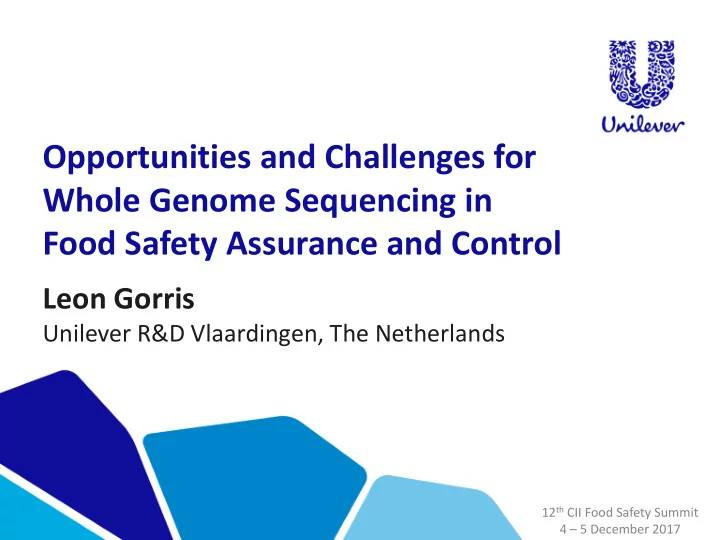

Opportunities and Challenges for Whole Genome Sequencing in Food Safety Assurance and Control Leon Gorris Unilever R&D Vlaardingen, The Netherlands 12 th CII Food Safety Summit 4 – 5 December 2017
Outline • Next Generation Sequencing approaches • WGS opportunities • WGS challenges https://www.genengnews.com/gen-articles/next-generation-sequencing-challenges/5953 2
NGS / WGS - OVERVIEW 3 Amended from Frédéric René (2016)
NGS / WGS - OVERVIEW FOOD PRODUCTS Water, RMs, Facilities, Environments HUMAN Microbiota Clinical samples 4 Amended from Frédéric René (2016)
NGS / WGS - OVERVIEW Food Safety FOOD PRODUCTS Foodborne outbreaks Water, RMs, Facilities, Source Environments tracking HUMAN Microbiota Food Clinical Authenticity samples & Food Fraud 5 Amended from Frédéric René (2016)
WGS: “GAINING SPEED OVER CONVENTIONAL MICRO” 1 day 1-2 days Weeks Conventional Microbiology 1 day 12-18 hours -Sampling Whole Genome Sequencing -Sequencing -Bioinf.analysis -Phylo.tree takes ~ 1 week Next Generation Sequencing Workshop 6
Outline • Next Generation Sequencing approaches • WGS opportunities • WGS challenges https://www.genengnews.com/gen-articles/next-generation-sequencing-challenges/5953 7
Designing safe and stable products in a highly diverse product portfolio Wide range of micro-organisms to understand in terms of ecology, physiology & preservation/control Molecular biology toolbox 8
Molecular biology toolbox • Eco-typing studies; microbiomes metagenomics • global gene expression profiling meta-transcriptomics • Single organism gene expression profiling transcriptomics • identifying biomarkers/intervention targets metabolic pathway modelling • genotype/phenotype correlations genomic analysis 9
Tools for innovation • Mechanistic understanding of microbial properties, e.g. - spoilage, safety • Innovation of preservation systems - preservation targets, resistance traits • Validating safe product and process designs, e.g. - challenge testing context 10
Supporting Food safety risk assessments “Growth & “Pathogenicity, Inactivation Virulence” kinetics” 11
Trouble shooting • Identifying micro-organisms / unravelling communities - Phylogenetic and functional classification • Investigational / root-cause analysis - Targeted follow-up of traditional microbiology - Tracing & tracking 12
Simplifying laboratory analyses Eva Møller Nielsen, PhD FAO Headquarters, Rome, Italy (23-25 May 2016)
Potentially “preventative” (1) Steven M. Musser, PhD and Ruth Timme, PhD Campden BRI, Chipping Campden UK (19 May 2016)
Potentially “preventative” (2) Steven M. Musser, PhD and Ruth Timme, PhD Campden BRI, Chipping Campden UK (19 May 2016)
Identifying more (small) clusters Christopher Braden CFS-UnivGeorgia Annual meeting (1 March 2016)
Ruth Timme, PhD IAFP 2016, WGS Workshop (30 July 2016)
GROWING THE DATABASE Ruth Timme, PhD IAFP 2016, WGS Workshop (30 July 2016)
OPEN DATABASE Ruth Timme, PhD IAFP 2016, WGS Workshop (30 July 2016)
GOING INTERNATIONAL Ruth Timme, PhD IAFP 2016, WGS Workshop (30 July 2016)
Outline • Next Generation Sequence Interests • WGS Opportunities • WGS Challenges 21
“WGS applications in food safety management, could contribute to greater consumer protection, trade facilitation, and food/nutrition security.” “Countries around the world use WGS or consider using it for food safety: Argentina, Australia, Brazil, Canada, China, Denmark, Germany, Italy, Japan, Kenya, South-Africa, Spain, UK, USA,……….”
http://www.icmsf.org/events/past_conferences.html 47 th CCFH WGS Side event Boston, 12 November 2015
Whole Genome Sequencing (WGS) SCIENTIFIC ROBUSTNESS QUESTIONS Are scientific studies available to validate the correct interpretation of finding particular genetic profiles in homes, environments or business operations? Is the technology mature enough for us to understand the relationship between genotypic traits of isolates and actual risk to public health, rather than hazard presence? What about quantification, given differences in regulatory limits of pathogens globally? Is there clarity on the regulatory response when “interesting” or “suspect” WGS profiles are found to be associated between “field” & database profiles? 47 th CCFH WGS Side event Boston, 12 November 2015
RESPONDING TO ASSOCIATIONS Steven M. Musser, PhD and Ruth Timme, PhD Campden BRI, Chipping Campden UK (19 May 2016)
JOBs TO BE DONE!? Value of information: - Method standardization & protocol harmonization to maximize comparability. - Quality Assurance challenge underestimated? Validity of interpretation : - Rather immature science area; demanding capability; genotype versus phenotypic expression/epidemiology; challenge to use data in risk-based food safety management Legal matters : - Ownership : 3 rd Party data generation & storage, external collaborations; public storage/sharing - Consequences : “false positive” associations in enforcement context; “legacy” cases raised; “risk communication during investigations” - Governance : little involvement of legal experts in developments Training and Education : - A global and local challenge, less for technical skills then for operational application 26
http://www.fao.org/3/a-i5619e.pdf 27
Utility of WGS – positive outlook WGS as a new research tool / risk assessment input - Microbial ecology, microbiome,…. - Preservations systems, tolerance, preservation targets,….. - Resistance mechanisms, resistance anticipation/avoidance, AMR,….. WGS as a investigational tool : - Outbreak investigation, attributing cases to outbreaks,….. - Root cause analysis, trouble shooting,…. WGS as a identification tool: - Identification of microorganisms….. WGS as an early warning tool: - Identification of possible associations between illness cases and microorganisms….. - Sharing of WGS data leverages resources to broaden the reference base 28
Investments needed Eva Møller Nielsen, PhD FAO Headquarters, Rome, Italy (23-25 May 2016)
Management consequences? In house Management Action Data Interpretation Data Generation https://www.dashingd3js.com/about Outsource
THANK YOU leon.gorris@unilever.com
Recommend
More recommend